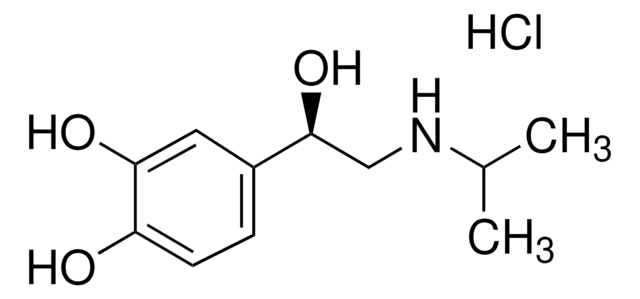537075
(±)-Propranolol, Hydrochloride
A highly lipophilic agent that blocks both β₁ and β₂ adrenergic receptors with equal potency.
Sinónimos:
(±)-Propranolol, Hydrochloride, (±)-1-(Isopropylamino)-3-(1-naphthyloxy)-2-propanol, HCl
About This Item
Productos recomendados
Nivel de calidad
Ensayo
≥97% (HPLC)
Formulario
powder
fabricante / nombre comercial
Calbiochem®
condiciones de almacenamiento
OK to freeze
color
white
solubilidad
methanol: soluble
water: soluble
Condiciones de envío
ambient
temp. de almacenamiento
−20°C
InChI
1S/C17H23NO2.ClH/c1-13(2)10-18-11-15(19)12-20-17-9-5-7-14-6-3-4-8-16(14)17;/h3-9,13,15,18-19H,10-12H2,1-2H3;1H
Clave InChI
RTTYPFXTLKDXPS-UHFFFAOYSA-N
Descripción general
Acciones bioquímicas o fisiológicas
β1 and β2 adrenergic receptors
Advertencia
Reconstitución
Otras notas
Glennon, R.A., et al. 1996. Mol. Pharmacol.49, 198.
Thompson, N.T., et al. 1991. Trends Pharmacol. Sci.12, 404.
Hoffman, B.B., and Lefkowitz, R.J. 1990. in The Pharmacological Basis of Therapeutics (Gilman, A.G., et al., Eds.) p. 221, Pergamon Press, New York.
Información legal
Palabra de señalización
Warning
Frases de peligro
Consejos de prudencia
Clasificaciones de peligro
Acute Tox. 4 Oral
Código de clase de almacenamiento
11 - Combustible Solids
Clase de riesgo para el agua (WGK)
WGK 3
Punto de inflamabilidad (°F)
Not applicable
Punto de inflamabilidad (°C)
Not applicable
Certificados de análisis (COA)
Busque Certificados de análisis (COA) introduciendo el número de lote del producto. Los números de lote se encuentran en la etiqueta del producto después de las palabras «Lot» o «Batch»
¿Ya tiene este producto?
Encuentre la documentación para los productos que ha comprado recientemente en la Biblioteca de documentos.
Los clientes también vieron
Filtros activos
Nuestro equipo de científicos tiene experiencia en todas las áreas de investigación: Ciencias de la vida, Ciencia de los materiales, Síntesis química, Cromatografía, Analítica y muchas otras.
Póngase en contacto con el Servicio técnico








